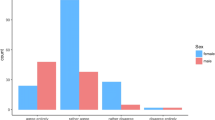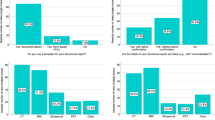Abstract
Quality in MR imaging is a comprehensive process that encompasses scanner performance, clinical processes for efficient scanning and reporting, as well as data-driven improvement involving measurement of key performance indicators. In this paper, the authors review this entire process. This article provides a framework for establishing a successful MR quality program. The collective experiences of the authors across a spectrum of pediatric hospitals is summarized here.



Similar content being viewed by others
References
Institute of Medicine Committee on Quality of Health Care in America, Kohn LT, Corrigan JM et al (eds) (2000) To err is human: building a safer health system. National Academies Press, Washington, DC
Hillman BJ, Amis ES Jr, Neiman HL, FORUM participants (2004) The future quality and safety of medical imaging: proceedings of the third annual ACR FORUM. J Am Coll Radiol 1:33–39
International Organization for Standardization (2020) ISO 9000 family: quality management. ISO. https://www.iso.org/iso-9001-quality-management.html. Accessed 22 Dec 2020
International Organization for Standardization (2015) ISO 9000:2015(en): quality management systems — fundamentals and vocabulary, clause 3.3.6. ISO. https://www.iso.org/obp/ui/#iso:std:iso:9000:ed-4:v1:en. Accessed 22 Dec 2020
Aakre KT, Valley TB, O'Connor MK (2010) Quality initiatives: improving patient flow for a bone densitometry practice: results from a Mayo Clinic radiology quality initiative. Radiographics 30:309–315
American Society for Quality (2006) The define, measure, analyze, improve, control (DMAIC) process. ASQ. http://www.asq.org/learn-about-quality/six-sigma/overview/dmaic.html. Accessed 22 Dec 2020
Swensen SJ, Johnson CD (2005) Radiologic quality and safety: mapping value into radiology. J Am Coll Radiol 2:992–1000
Price R, Allison J, Clarke G et al (2015) Magnetic resonance imaging quality control manual. American College of Radiology, Reston
Jackson EF, Bronskill MJ, Drost DJ et al (2010) Acceptance testing and quality assurance procedures for magnetic resonance imaging facilities. American Association of Physicists in Medicine, College Park
American College of Radiology (2019) ACR–AAPM technical standard for diagnostic medical physics. American College of Radiology, Reston
International Society for Magnetic Resonance in Medicine (n.d.) Quantitative MR study group. ISMRM. https://www.ismrm.org/study-groups/quantitative-mr/. Accessed 22 Dec 2020
Radiological Society of North America (2015) Quantitative imaging biomarkers Alliance. RSNA. https://www.rsna.org/en/research/quantitative-imaging-biomarkers-alliance/. Accessed 22 Dec 2020
ESR Research Committee and European Imaging Biomarkers Alliance (EIBALL). ESR. https://www.myesr.org/research/esr-research-committee. Accessed 22 Dec 2020
Kelly AM, Cronin P (2015) Practical approaches to quality improvement for radiologists. Radiographics 35:1630–1642
American College of Radiology (n.d.). Clinical decision support. ACR. https://www.acr.org/Clinical-Resources/Clinical-Decision-Support. Accessed 22 Dec 2020
American College of Radiology (2020) ACR appropriateness criteria. ACR. https://acsearch.acr.org/list?_ga=2.82677077.29061605.1593844183-426837578.1551014847. Accessed 22 Dec 2020
Jaimes C, Gee MS (2016) Strategies to minimize sedation in pediatric body magnetic resonance imaging. Pediatr Radiol 46:916–927
Calamante F, Ittermann B, Kanal E et al (2016) Recommended responsibilities for management of MR safety. J Magn Reson Imaging 44:1067–1069
Kanal E, Barkovich AJ, Bell C et al (2013) ACR guidance document on MR safe practices. J Magn Reson Imaging 37:501–530
Shellock FG (n.d.). Mrisafety.com screening form. Online document. http://www.mrisafety.com/ScreeningForm.html. Accessed 22 Dec 2020
Mason KP, Fontaine PJ, Robinson F, Zgleszewski S (2012) Pediatric sedation in a community hospital-based outpatient MRI center. AJR Am J Roentgenol 198:448–452
Serai SD, Rigsby CK, Kan HJ et al (2018) Inclusion of pediatric-specific indications and procedures in the new ACR MRI accreditation program. J Am Coll Radiol 15:1022–1026
Mulkern RV, Forbes P, Dewey K et al (2008) Establishment and results of a magnetic resonance quality assurance program for the pediatric brain tumor consortium. Acad Radiol 15:1099–1110
Greer MC (2018) Whole-body magnetic resonance imaging: techniques and non-oncologic indications. Pediatr Radiol 48:1348–1363
Rees MA, Dillman JR, Anton CG et al (2019) Inter-radiologist agreement using Society of Abdominal Radiology–American Gastroenterological Association (SAR–AGA) consensus nomenclature for reporting CT and MR enterography in children and young adults with small bowel Crohn disease. Abdom Radiol 44:391–397
Canadian Medical Protective Association (2019) Closing the loop on effective follow-up in clinical practice. CMPA. https://www.cmpa-acpm.ca/en/advice-publications/browse-articles/2019/closing-the-loop-on-effective-follow-up-in-clinical-practice. Accessed 22 Dec 2020
Goldberg-Stein S, Frigini LA, Long S et al (2017) ACR RADPEER committee white paper with 2016 updates: revised scoring system, new classifications, self-review, and subspecialized reports. J Am Coll Radiol 14:1080–1086
Shailam R, Botwin A, Stout M, Gee MS (2018) Real-time electronic dashboard technology and its use to improve pediatric radiology workflow. Curr Probl Diagn Radiol 47:3–5
Rascovsky SJ, Delgado JA, Sanz A et al (2012) Informatics in radiology: use of CouchDB for document-based storage of DICOM objects. Radiographics 32:913–927
Paulden M, McCabe C, Karnon J (2014) Achieving allocative efficiency in healthcare: nice in theory, not so NICE in practice? Pharmacoeconomics 32:315–318
Donnelly LF (2017) Daily readiness huddles in radiology — improving communication, coordination, and problem-solving reliability. Curr Probl Diagn Radiol 46:86–90
Donnelly LF, Cherian SS, Chua KB et al (2017) The daily readiness huddle: a process to rapidly identify issues and foster improvement through problem-solving accountability. Pediatr Radiol 47:22–30
Somlo DRM, Reppenning NP, Mangi AA. Improving patient flow with dynamic work design; 2018. NEJM Catalyst. https://catalyst.nejm.org/doi/full/10.1056/CAT.18.0160. Accessed 19 July 2020
Morgan MB, Branstetter 4th BF, Lionetti DM et al (2008) The radiology digital dashboard: effects on report turnaround time. J Digit Imaging 21:50–58
Recht M, Macari M, Lawson K et al (2013) Impacting key performance indicators in an academic MR imaging department through process improvement. J Am Coll Radiol 10:202–206
Alvarado K (2007) Factors influencing implementation of medical directives by registered nurses: the experience of a large Ontario teaching hospital. Nurs Leadersh 20:72–90
Major VJ, Aphinyanaphongs Y (2020) Development, implementation, and prospective validation of a model to predict 60-day end-of-life in hospitalized adults upon admission at three sites. BMC Med Inform Decis Mak 20:214
Wang E, Brenn RB, Matava CT (2020) State of the art in clinical decision support applications in pediatric perioperative medicine. Curr Opin Anaesthesiol 33:388–394
Author information
Authors and Affiliations
Corresponding author
Ethics declarations
Conflicts of interest
Mai-Lan Ho is the principal investigator of a Siemens Healthineers/Radiological Society of North America Research Scholar grant, has received the Society for Pediatric Radiology Pilot Award, has received the William N. Hanafee grant from the American Society of Head and Neck Radiology, and is a co-investigator for an American College of Radiology Innovation Fund grant. Andrea S. Doria is the principal investigator of research grants from Baxalta-Shire, the Terry Fox Foundation and the PSI Foundation.
Additional information
Publisher’s note
Springer Nature remains neutral with regard to jurisdictional claims in published maps and institutional affiliations.
Rights and permissions
About this article
Cite this article
Sreedher, G., Ho, ML., Smith, M. et al. Magnetic resonance imaging quality control, quality assurance and quality improvement. Pediatr Radiol 51, 698–708 (2021). https://doi.org/10.1007/s00247-021-05043-6
Received:
Revised:
Accepted:
Published:
Issue Date:
DOI: https://doi.org/10.1007/s00247-021-05043-6




